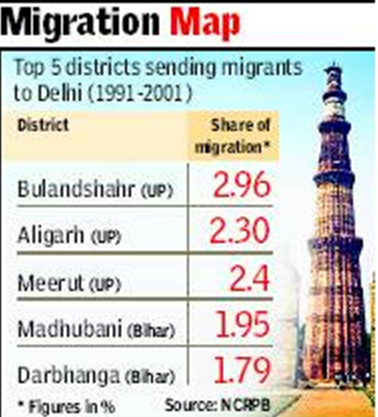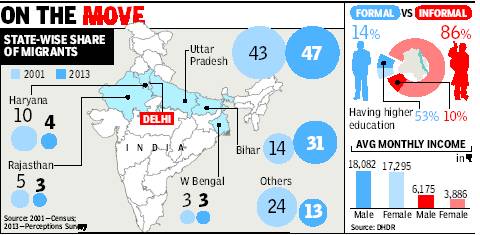Delhi: Migration to
This is a collection of articles archived for the excellence of their content. Readers will be able to edit existing articles and post new articles directly |
Contents |
Historical trends
2001-2017: Delhi becomes the migrant capital of India
March 23, 2018: The Times of India
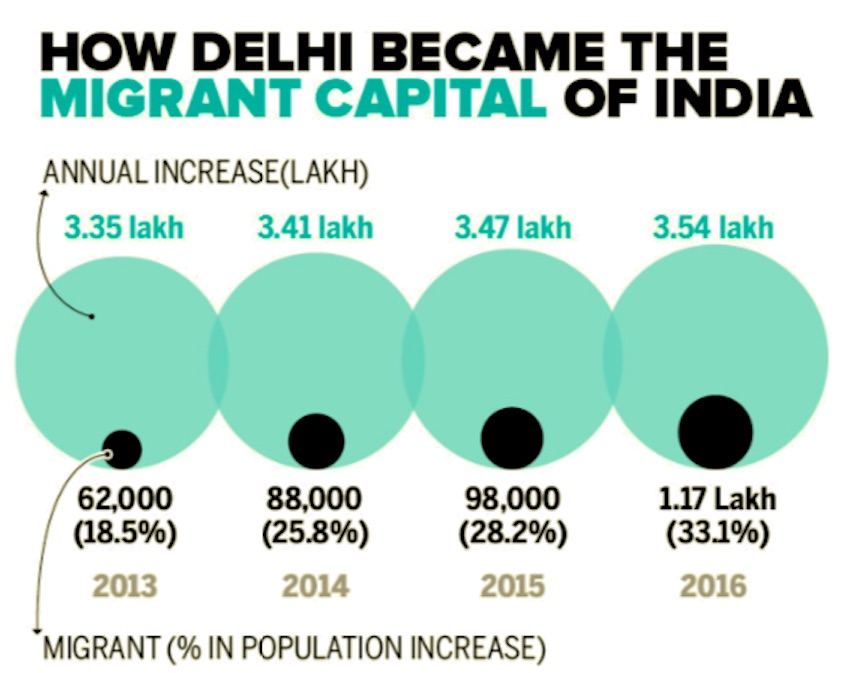
From: March 23, 2018: The Times of India
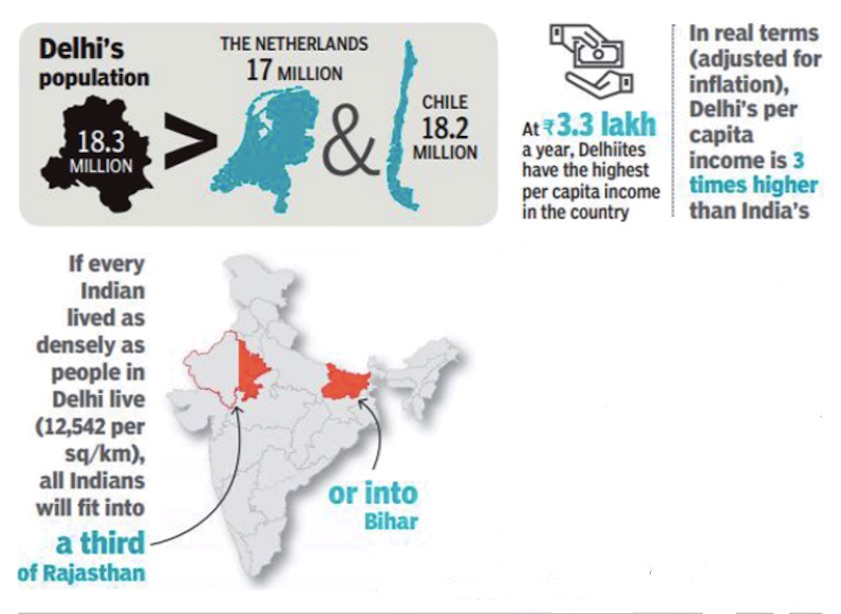
From: March 23, 2018: The Times of India
The population of Delhi grew by nearly 1,000 a day in 2016, out of which over 300 were migrants who came to the city to settle down. The share of migrants in the capital’s population growth reached 33% in 2016 — highest in 15 years. New Delhi’s booming services economy and its highest per capita income among states makes it the number 1 destination for migrants from all parts of the country.
2001, ‘05, ’11: Reasons for migration, age group
Paras Singh & Jasjeev Gandhiok, August 11, 2019: The Times of India

From: Paras Singh & Jasjeev Gandhiok, August 11, 2019: The Times of India
With its infrastructural advances and high economic growth, Delhi attracts economic migrants by the drove — of the city’s 63.3 lakh migrant population in Census 2011, almost a third, or 19.3 lakh, had come to the capital to exploit employment and livelihood opportunities. This figure might actually be higher because the hold-all category of 22 lakh described as having shifted to Delhi with their household would also include most who had moved for economic reasons.
Among the other reasons why people came to Delhi, according to the 2011 Census, were marriage, with almost a fifth of the migration propelled by this, education and business. Of those who cited marriage for the shift to the capital, 98% were women. In 2011, there were 96,600 outsiders who were in the city for the primary reason of receiving education, while 46,600 were based in Delhi for business purposes.
The economic argument for migration is strengthened by the fact of most migrants being in the peak productivity age group of 20-34 years. Five lakh people aged 25-29 years, 3.2 lakh aged 30-34 and 4.2 lakh aged 20-24 years made Delhi their home between 2001 and 2011 compared with just around 60,000 senior citizens (60+ years).
Sociologist Satish Deshpande of Delhi University said it has been a trend for the past several decades for men to come to the city for jobs and the women through marriage. “Delhi might not offer too many jobs, but it is the capital and offers hope. People from the hinterland don’t come with job offers, but in the hope of finding jobs,” nuanced Deshpande. As for the migration of women, he explained that the single biggest reason has always been marriage, not only in Delhi’s case, but for other states too.
For people from regions like Kerala, Maharashtra and the Northeast, the magnet was employment opportunities. For those from Punjab and Chandigarh, Delhi mattered for reasons of the heart — more people moved to the capital due to matrimony than for education, business or employment opportunities.
Confederation of Indian Industry reported that in 2005-06, almost 80% of Delhi’s industrial sector comprised tertiary services, with the city offering a large number of jobs in transport, storage, business process outsourcing, banking, financial services and insurance, agri and processed food, information technology, tourism and logistics. Construction and real estate sectors were key drivers of job opportunities.
Praveen Khandelwal, general secretary, Confederation of All India Traders, said that the economic options offered by the city state are unparalleled. “Most of the migrants are from rural areas who think that catering to Delhi’s two crore population will enable them to start some kaam-dhandha (small scale work),” he said. Khandelwal added that the city’s 29 industrial areas provide employment from supervisory level jobs to drivers and manual labour and also the chance to enhance basic skills.
Taking 2005-06 as the reference point for the decade under study, the Economic Survey of Delhi said, “The manufacturing sector in Delhi contributes about 12% to the state income. The industries department estimates indicate that about 1.3 lakh industrial units were functioning in Delhi, which provided employment to more than 14 lakh persons.” In the unorganised manufacturing sector, the number of enterprises was estimated at 1.9 lakh, among the bigger sections beings apparels (27.4%), metal products (13.9%) and furniture (10.8%).
As for education, with 23 universities and 186 colleges, the capital is a veritable knowledge hub. Education experts say that there are no other states with so many universities within such a small geography. In addition, there are four institutes of national importance and 13 lakh enrolled students in institutes of higher education.
Areas from which migrants come to Delhi
UP, Bihar
Most migrants in city still from UP, but Bihar’s share rising fast
TIMES INSIGHT GROUP
The Times of India 2013/09/01
New Delhi: Delhi has always been a melting pot — people from across the country come here to study or to work. But in the past decade there appears to have been a change in the composition of its population. Uttar Pradesh continues to be the state from which the largest share of migrants come to Delhi—about 47%, up from about 43% in 2001. But the biggest change is from Bihar—migrants from this state have shot up from 14% in 2001 to nearly 31% in 2013.
The data for 2013 is from a Perceptions Survey of 8,029 persons conducted by the Institute for Human Development for the Delhi government as part of Delhi’s Human Development Report 2013 (DHDR). Although not strictly comparable with the headcount of a census, it does give an indication of the changing face of Delhi. People who came to Delhi up to 20 years ago were considered migrants for the survey.
The bulk of migrants still give employment related factors for coming all the way to the national capital, according to the survey. But there is an increasing proportion that gives ‘education and training’ as the reason. Among those who migrated to Delhi a decade ago, about three quarters said they came looking for jobs or better salaries, while only 18% came for education. But among those who came to Delhi within the last one year, 40% said they were studying while 57% came for job related reasons, the DHDR said.
Delhi has emerged as a hub for the services sector and its earlier base of industry has eroded, according to the DHDR. Over 85% of Delhi’s gross state domestic product arises from the services sector while industry contributes just 14%. Accordingly, the nature of employment available in the city has also changed.
However, the growth of the services sector has also brought with it a growth of highly vulnerable, low-paid and informal jobs. Among the top 10 jobs in Delhi, in terms of number of persons employed, most are of this kind—shop workers, construction workers, transport workers (including rickshaw drivers), maids, cooks, security personnel, repair mechanics, street vendors, clerks, delivery persons etc. This is the army of service providers that sustains the city—they make up about 86% of workers in the city.
On average, a male informal worker gets Rs 6,175 compared to Rs 18,082 for a formal worker. A female informal worker gets just Rs 3,886 compared to Rs 17,295 for the formal counterpart, the report said, quoting a 2010 survey. This workforce is highly skewed towards male workers. Only about 11% of women are working while 55% men have jobs.
Bulandshahr roads lead to Delhi
Dipak Kumar Dash | TNN
New Delhi: Among 1.6 lakh migrants who make their way to Delhi every year, Bulandshahr district of Uttar Pradesh sends the maximum number, followed by Aligarh. A districtwise report shows that as many as six UP districts are among the top ten in terms of migration, which includes Bihar’s Darbhanga and Madhubani.
While UP being the largest contributor of migrants and Bihar fast catching up is well known, a listing of the top 100 districts whose residents make it to the capital makes for an interesting read. Meerut is ranked third while Ghaziabad is at six, followed by Etah and Azamgarh. Then, there is Chatra in Jharkhand and Patna.
These 100 districts contribute to about 75% of the total migration to Delhi and NCR.
The list, put out by the NCR planning board (NCRPB), indicates that distance is not a deciding factor — the migration map stretches from nextdoor western UP to Azamgarh in the eastern part of the state. Experts point out that distance notwithstanding, economic factors and family migration are powerful drivers. Rajasthan and Haryana are dropping down the list, perhaps, due to improving economic conditions.
However, among the top 20 districts, 11 are within 300km from Delhi. That districts such as Panipat, Rewari, Gautam Budh Nagar (Noida), Gurgaon, Faridabad and Alwar rank lower in this ladder also indicates how augmentation of physical and social infrastructure besides economic development in these regions have contributed to absorb the employable workforce.
2001-11: The main source regions
Paras Singh & Jasjeev Gandhiok, July 31, 2019: The Times of India
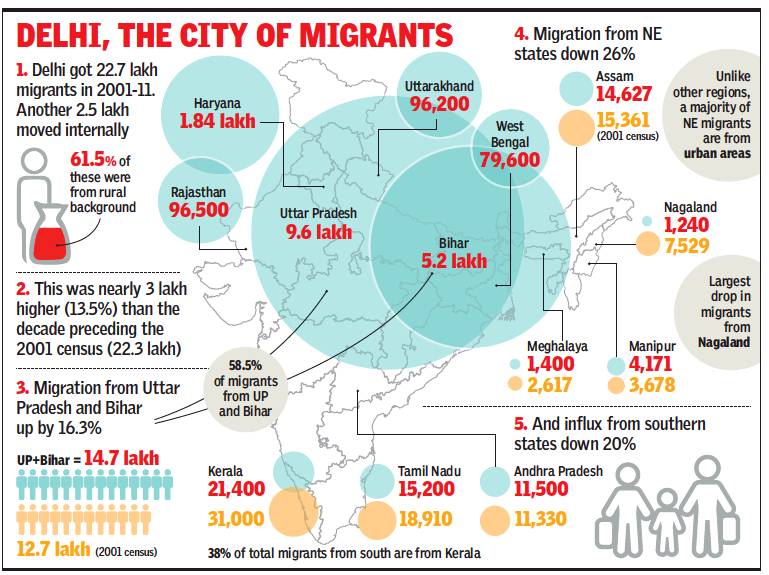
From: Paras Singh & Jasjeev Gandhiok, July 31, 2019: The Times of India
Fewer people from NE and southern states making capital their home
MOVERS & SHAKERS: Poorvanchalis Stay At Top With 2-Lakh Jump In Numbers In 10 Years
New Delhi:
Delhi has always been a city of migrants. In the decade between 2001 and 2011, 22.7 lakh people arrived to make the capital their home. Another 2.5 lakh moved within the city. Migration has had its significance for politics in the capital, but the dynamics are not stable. The nature of influx changed in the previous decade, and while Poorvanchalis — migrants from Uttar Pradesh and Bihar to the east of the capital — remain the dominant outsiders, there is a big drop in the arrival in Delhi of people from the Northeast and south India.
The number of migrants from north-eastern states is down 26% and from the four southern states, 20%. Comparably, between the census years of 2001 and 2011, migrants shifting to Delhi from Uttar Pradesh and Bihar show a 16.3% jump, or 14.7 lakh people against 12.7 lakh in the previous decade.
Social scientist Shiv Visvanathan seemed to believe that the harassment faced by them in Delhi could have affected the decision of people from the Northeast not to shift to the capital. “Stereotypes are being built around them, so why would they not go down south where they are more welcome?” asked Visvanathan. “The UP and Bihar influx is so large that you cannot use stereotypes.”
Visvanathan observed some interesting trends in intra-country migration. “The Northeast is moving south, Orissa is moving to Kerala, and UP and Bihar are coming to Delhi. And if you look at the southern states, they are looking at the Gulf countries rather than Delhi,” said Visvanathan.
Professor Satish Deshpande, Delhi University sociologist, however, pointed out that the incidents of racial violence against Northeasterners were sporadic while the census migration data was obtained at fixed point of time. “The overall trends about reduction in migration from the Northeast and southern states are interesting, but since the data is comparative in nature it is difficult to ascribe reasons to these changes. The increase in non-migrants too needs to be looked at,” said Deshpande. While the 13.5% jump in migrant population shows Delhi is still a top destination for those who want a new home, the number of those from the Northeast dipped from 32,859 to 24,314 between 2001 and 2011, with Nagaland showing the biggest slide from 7,529 to 1,240. The Assamese people constitute the bulk of the migrants from that region. The four southern states — Andhra Pradesh, Karnataka, Kerala and Tamil Nadu — similarly sent fewer people to Delhi. There was a decrease from around 70,000 to 56,000 in this period. Keralites remain the dominant group among south Indians but their number has decreased from around 31,000 to 21,000.
There were no surprises related to the Poorvanchalis. “In contrast to the problem-beset Bihari migration to Maharashtra, the Poorvanchalis are almost seen as the makers of modern Delhi. They offer a counterweight to Lutyens’ Delhi in the capital’s politics now,” explained Visvanathan. Besides the Poorvanchalis, other states sending their people to Delhi include Haryana (1.8 lakh), Rajasthan (96,574) Uttarakhand (96,244) and West Bengal (79,681).
The changing profile of the migrant population means new power centres have emerged in the past decade. The Punjabi-trader community — once the focus of Delhi’s political discourse — has ceded space to Poorvanchalis, with the last two BJP party chiefs featuring from this community.
With more than 30% of the capital’s voters originating from the so-called Poorvanchal region, political parties can ignore the Poorvanchalis at their own peril. “They are no longer just a pressure group or a community appeased, as earlier, with the offer of low-level posts,” said Sanjay Kumar, political expert at the research institute Centre for the Study of Developing Societies. Kumar noted that Poorvanchalis have received nominations to fight elections in increasing numbers from the 2013 assembly elections onwards. “That year was the watershed moment in which the Poorvanchalis’ winnability was proved,” Kumar said.
According to political experts, in around 30 of Delhi’s 70 assembly constituencies, the Poorvanchalis play an important role. They are also dominant in the electorates of the East, North East, North West and West Delhi parliamentary constituencies.
Pattern of migration
Family migration has pushed up city’s population/ 2001
New Delhi: While UP is the largest contributor of migrants to Delhi, Bihar is fast catching up. The NCRPB study, citing 2001 Census figures, has concluded that UP and Bihar put together have the highest share of migrants — 64.25%. Interestingly, while there was sharp decline of migrants from Haryana — from 11.51% during 1981-91 to 7.87% during 1991-2001 — the count has increased significantly in case of Bihar. The comparative data shows migration from Bihar shot up from 10.69% during 1981-1991 to 19.09% in the next decade.
‘‘We have no planning for the development of smaller districts. The situation has worsened everywhere, including in areas close to Delhi such as Khurja and Bulandshahr,’’ says urban town planner H R Suri. ‘‘In the name of decongesting Delhi, if we allow crowding of the areas bordering the capital, there will be no relief. We are inviting a bigger problem,’’ says the former president of Institute of Town Planners of India. Bengal figures on the list too, with districts such as Kolkata, Medinipur, Malda, North 24-Paraganas, Cooch Behar and Uttar Dinajpur indicating paucity of jobs.
While popular opinion is that job opportunities in Delhi-NCR have pushed up migrant population in the past, the report reveals that in the past decades, family migration has contributed to the trend more. ‘Moving with household’ was the second major reason for migration to this economically prosperous region. ‘‘Earlier, the earning member used to live in Delhi and there was a trend that they would send money to their families in villages. But now, that has changed. A few months after getting jobs, they are bringing their families,’’ said urban transport planner Prof N Ranganathan. The study shows the sex ratio of migrants is 785 females per 1,000 males.
It also shows that development of five counter-magnet areas — Hissar, Bareilly, Patiala, Kota and Gwalior — have been partially successful in absorbing the migration from those regions to NCR. Now it has included three more cities in this list — Ambala in Haryana, Kanpur in UP and Dehra dun in Uttarakhand.
See also
National Capital Region (India): Demographic Profile and Settlement Pattern
Delhi: Migration to
